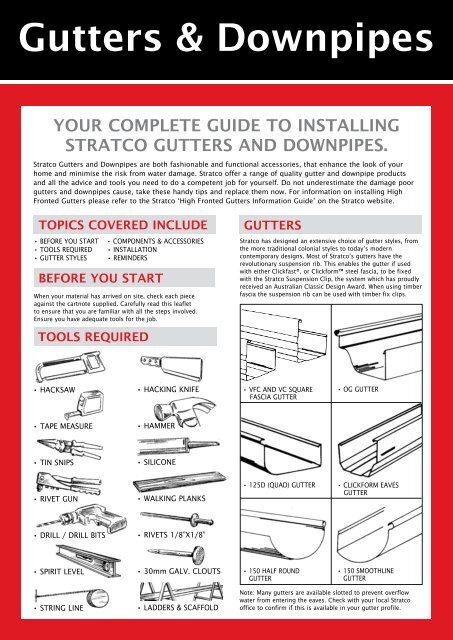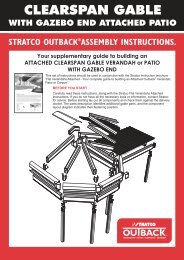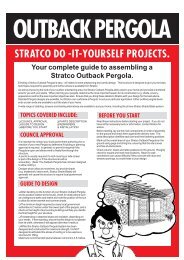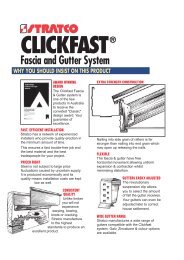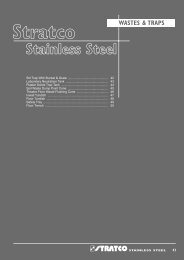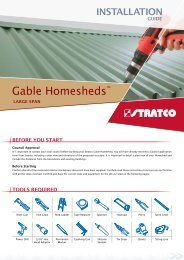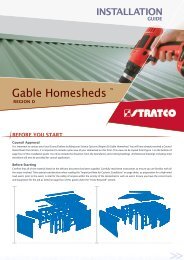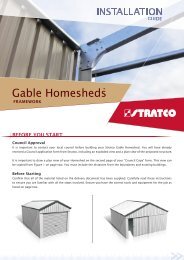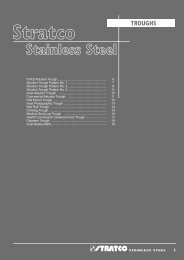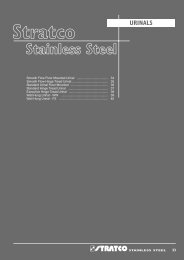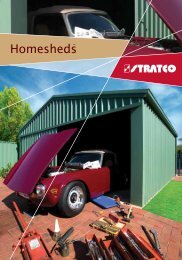Gutters & Downpipes - Stratco
Gutters & Downpipes - Stratco
Gutters & Downpipes - Stratco
Create successful ePaper yourself
Turn your PDF publications into a flip-book with our unique Google optimized e-Paper software.
<strong>Gutters</strong> & <strong>Downpipes</strong><br />
YOUR COmPLETE GUIDE TO INSTALLING<br />
STRATCO GUTTERS AND DOwNPIPES.<br />
<strong>Stratco</strong> <strong>Gutters</strong> and <strong>Downpipes</strong> are both fashionable and functional accessories, that enhance the look of your<br />
home and minimise the risk from water damage. <strong>Stratco</strong> offer a range of quality gutter and downpipe products<br />
and all the advice and tools you need to do a competent job for yourself. Do not underestimate the damage poor<br />
gutters and downpipes cause, take these handy tips and replace them now. For information on installing High<br />
Fronted <strong>Gutters</strong> please refer to the <strong>Stratco</strong> ‘High Fronted <strong>Gutters</strong> Information Guide’ on the <strong>Stratco</strong> website.<br />
TOPICS COVERED INCLUDE<br />
• BEFORE YOU START • COMPONENTS & ACCESSORIES<br />
• TOOLS REQUIRED • INSTALLATION<br />
• GUTTER STYLES • REMINDERS<br />
BEFORE YOU START<br />
When your material has arrived on site, check each piece<br />
against the cartnote supplied. Carefully read this leaflet<br />
to ensure that you are familiar with all the steps involved.<br />
Ensure you have adequate tools for the job.<br />
TOOLS REQUIRED<br />
• HACKSAW<br />
• TAPE MEASURE<br />
• TIN SNIPS<br />
• RIVET GUN<br />
• DRILL / DRILL BITS<br />
• SPIRIT LEVEL<br />
• STRING LINE<br />
• HACKING KNIFE<br />
• HAMMER<br />
• SILICONE<br />
• WALKING PLANKS<br />
• RIVETS 1/8”X1/8”<br />
• 30mm GALV. CLOUTS<br />
• LADDERS & SCAFFOLD<br />
GUTTERS<br />
<strong>Stratco</strong> has designed an extensive choice of gutter styles, from<br />
the more traditional colonial styles to today’s modern<br />
contemporary designs. Most of <strong>Stratco</strong>’s gutters have the<br />
revolutionary suspension rib. This enables the gutter if used<br />
with either Clickfast®, or Clickform steel fascia, to be fixed<br />
with the <strong>Stratco</strong> Suspension Clip, the system which has proudly<br />
received an Australian Classic Design Award. When using timber<br />
fascia the suspension rib can be used with timber fix clips.<br />
• VFC AND VC SQUARE<br />
FASCIA GUTTER<br />
• 125D (QUAD) GUTTER<br />
• 150 HALF ROUND<br />
GUTTER<br />
• OG GUTTER<br />
• CLICKFORM EAVES<br />
GUTTER<br />
• 150 SMOOTHLINE<br />
GUTTER<br />
Note: Many gutters are available slotted to prevent overflow<br />
water from entering the eaves. Check with your local <strong>Stratco</strong><br />
office to confirm if this is available in your gutter profile.
ACCESSORIES<br />
MITRES<br />
INTERNAL/EXTERNAL<br />
GUTTER STRAPS:<br />
INTERNAL / EXTERNAL<br />
SUSPENSION CLIPS<br />
DOWNPIPES<br />
ELBOWS &<br />
SHOES<br />
MITRE GUSSETS<br />
STOP ENDS<br />
P CLIPS<br />
PRE-INSTALLATION<br />
GUTTER OUTLETS<br />
MEASURING<br />
Measure length of fascia,<br />
allowing enough for mitres<br />
and any joints that may<br />
be required. Generally, Rivet and silicone stop ends<br />
external corners will<br />
require at least twice the width of the gutter to be sacrificed making<br />
the mitre, but internal corners require no extra material. Joins should<br />
overlap approx 100mm. If installing pre-made stop ends no extra<br />
length is required, but “return” stop ends require the width of the<br />
gutter to be added for each stop end.<br />
DETERMINE GUTTER SUPPORT<br />
There are 4 basic methods of supporting a gutter.<br />
A: External brackets.<br />
B: Internal straps and P clips.<br />
C: Internal straps and scotia.<br />
D: Suspension clips and internal straps.<br />
DETERMINE GUTTER FALLS<br />
1: Using a string line, nail one end to<br />
the fascia, running string line from<br />
corner to corner, making sure the<br />
string line is taut.<br />
2: The fall of the gutter should be<br />
calculated (correct fall is 1:500).<br />
Check the fall with a spirit level.<br />
The fall must run towards the<br />
gutter outlet.<br />
DOWNPIPE<br />
OFFSETS<br />
PRE-ASSEMBLE MITRES, STOP ENDS AND OUTLETS.<br />
Determine method of supporting and strengthening gutter on the<br />
fascia. Gutter support can include external brackets, or internal<br />
straps used in conjunction with either P-clips, timber scotia or<br />
suspension clips.<br />
1: Cut required length with hacksaw and tinsnips.<br />
2: Fit stop ends where required.<br />
3: Cut holes (outlets) for gutters with a hacking knife, and rivet outlet<br />
into position.<br />
4: Cut mitres where needed. Pre-made mitres are available. See the<br />
section on making mitres if you wish to make your own.<br />
5: Remove all swarf and debris from inside of gutters. If gutters<br />
are pre-coloured steel remove plastic from outside of gutters prior<br />
to installation.<br />
6: Seal internally all stop ends, gutter outlets and mitres with<br />
silicone sealant.<br />
7: Make downpipe offsets. Pre-made downpipe offsets are available,<br />
however see section on making offsets if you wish to make your own.<br />
INSTALLATION OF BRACKETS<br />
EXTERNAL BRACKETS<br />
Nail External brackets at 1.2 metre centres,<br />
following string line. Once all brackets<br />
have been installed, place gutters into<br />
external brackets. Bend tag over bead to<br />
hold in place<br />
P - CLIPS<br />
Install P-clips if required using the same<br />
method as external brackets. Once<br />
P-clips have been installed, sit gutters<br />
onto P-clip lip then bend small tag of<br />
P-clip over back of gutter to hold the<br />
gutter into position.<br />
INTERNAL STRAPS<br />
Install internal straps at 1.2 metre<br />
centres to hold face of gutter into<br />
position. Install pre-made mitres into<br />
corners. Internal straps can also be used<br />
in conjunction with gutter suspended on<br />
timber scotia nailed to a timber fascia.<br />
SUSPENSION CLIPS<br />
This can be used on steel & timber<br />
Fascia with Internal Straps. No string line<br />
is required. For timber fascia nail your<br />
timber suspension clip into place by<br />
placing a clout into the allocated hole in<br />
the top of the clip and driving the clout<br />
into the top of the timber fascia, holding<br />
the clip into position. Clips are to be<br />
placed at maximum of 1.2m centres.<br />
Steel fascia suspension clips are rolled<br />
over the top of steel fascia and placed<br />
into position at 1.2 m centres. (See<br />
section on steel fascia).<br />
Gutter and<br />
external<br />
bracket<br />
Without<br />
scotia,<br />
using<br />
P-clips and<br />
internal<br />
strap<br />
With<br />
scotia,<br />
using<br />
internal<br />
strap<br />
Without<br />
scotia,<br />
using<br />
timber<br />
suspension<br />
and internal<br />
strap<br />
Metal<br />
suspension<br />
clip and<br />
internal<br />
strap.<br />
INSTALLATION OF GUTTER<br />
1: Ensure all gutter outlets and stop ends are fitted at the correct<br />
locations prior to installation of the gutter.<br />
2: Place gutter on P-clips or scotia already<br />
installed and hold into place by driving<br />
a galvanised nail into the fascia just<br />
above the back of the gutter. Bend the<br />
nail down to hold the gutter but allow<br />
expansion and contraction.<br />
3: To install the next length of gutter,<br />
determine the fall of the gutter. Joins<br />
should always be overlapped to allow<br />
water to flow “over” the joint instead of<br />
“into” the joint. Open the bead of the<br />
“outside” gutter with a pair of pliers, and<br />
close up the bead of the “inside” gutter.<br />
4: Slide the upstream gutter (inside) into<br />
the downstream gutter (outside) allowing<br />
a 100mm lap. Rivet and silicone the two<br />
gutters together, ensuring that all metal<br />
filings (swarf) are first cleaned from the<br />
gutter. Silicone should be smoothed to<br />
ensure that the passage<br />
of water is not impeded.<br />
2:<br />
3:<br />
4:<br />
100mm
GUTTER INSTALLATION CONTINUED<br />
5: Fit pre-made gutter mitres as required.<br />
6: Roll internal straps into the bead of the gutter if being used and<br />
fasten to the top of the fascia. Use the gutter strap to ensure the<br />
bead remains parallel to the fascia.<br />
7: Fit downpipe, downpipe accessories and straps.<br />
INSTALLATION OF GUTTERS<br />
USING SUSPENSION CLIPS<br />
Gutter is pulled upwards until the suspension clip engages into the<br />
suspension rib of gutter. Place internal gutter strap into position.<br />
The fall of the gutter is obtained by a series of teeth placed on the<br />
suspension clip. The highest end of the gutter should be in the top<br />
tooth. The lowest end in the second to bottom (minimum 1: 500<br />
fall required).<br />
ROLL IN CLIPS.<br />
Push suspension clip up<br />
from rear and into the<br />
vertical<br />
position as<br />
shown.<br />
1 2<br />
3<br />
INSTALL GUTTER<br />
Pull gutter upwards until<br />
suspension clip engages.<br />
1: Measure the distance between the bottom<br />
of the gutter to the ground level (leave<br />
enough to fit a shoe or PVC fitting).<br />
2: Slide the small end of one downpipe<br />
(marked by a cut V or dot one end) into the<br />
big end of the other. Rivet the downpipe at<br />
the back as not to show the rivet head, then<br />
use a hacksaw to cut to the desired length.<br />
3: Fit the downpipe to the existing outlet<br />
using rivets, then using downpipe straps,<br />
fix against wall or post using screws or<br />
masonry nails.<br />
1: Determine if the end is to be left or right.<br />
2: Mark a line completely around the outside<br />
of the gutter at a distance from the end,<br />
equal to the width of the gutter.<br />
3: Mark a tag-line paralell to the first<br />
approximately 10mm toward the end of<br />
the gutter, across the back and the base of<br />
the gutter.<br />
4: Cut the back and the base from the gutter<br />
leaving the 10mm tags in place. Fold these<br />
up at 90 degrees.<br />
5: Cut a 45˚ notch in the bead of the gutter<br />
at the marked line, and fold the face of the<br />
gutter to form the end.<br />
6: Rivet and silicone.<br />
CLIP SPACING<br />
Knock suspension clip<br />
down with fist. Place at 1.2<br />
metre<br />
intervals.<br />
FIX INTERNAL STRAPS<br />
Roll gutter strap into bead<br />
& press over top of fascia.<br />
FIXING DOWNPIPE TO GUTTER<br />
MAKING ‘RETURN’ STOP ENDS<br />
4<br />
Steps 1-3<br />
Steps 4-5<br />
Steps 5-6<br />
Small<br />
end<br />
Large<br />
end<br />
DOWNPIPE OFFSETS<br />
When installing downpipes, sometimes<br />
the eaves overhang will require the use of<br />
a downpipe offset. There are two ways of<br />
producing a downpipe offset.<br />
1: <strong>Stratco</strong> produce a complete downpipe<br />
offset, which is suitable for your<br />
nominated eaves dimension. This has a<br />
slip joint to make it adjustable for small<br />
variances in eaves sizes, which may vary<br />
on your home.<br />
2: Elbows and shoes can also be pre-made<br />
and then riveted onto your downpipe<br />
length producing your own downpipe<br />
offset. Alternately, one piece downpipe<br />
offsets can be made on the site.<br />
CREATING THE “LOWER OFFSET” JOINT.<br />
Measure 1 from the wall<br />
to the outside<br />
of the gutter outlet.<br />
Add to this measurement 100mm plus<br />
twice the width of the downpipe.<br />
Measure the width of the downpipe.<br />
3 Mark this width on the face of the<br />
downpipe either side of the centre line<br />
to points B and C. To achieve an angle<br />
of approx. 100˚(which allows for downpipe<br />
fall) come in 10mm both sides to B1 and C1.<br />
On the big end side of the centre line come in<br />
a further 10mm for a lap to point B2.<br />
Join points B-A1, C1-A1, and draw a line<br />
parallell to B-A1 to intersect A-A1 at A2.<br />
4<br />
Using a hacksaw, cut<br />
a small section out<br />
inside the lines, big<br />
enough to gain access<br />
for your tinsnips.<br />
6<br />
Bend the downpipe along the undercut<br />
side to allow the big end of the<br />
downpipe to fit inside the lower part<br />
of the offset.<br />
Rivet and silicone.<br />
CREATING THE “UPPER<br />
OFFSET” JOINT<br />
Place completed “Lower Offset”<br />
1 joint against the wall with the<br />
large end of downpipe towards the<br />
gutter outlet.<br />
• Using a plumb line mark from the<br />
outside of the gutter outlet, completly<br />
down the side of downpipe. This point<br />
becomes the centre point of the cut of<br />
the upper offset joint, to be marked<br />
out. Cut and seal as per steps 3 to 6<br />
above. It is important to note that for the<br />
“Upper Offset” the opposite face of the<br />
downpipe is used so the seam is cut.<br />
• Before riveting the top of the offset<br />
joint completely, check to make sure the<br />
top of the offset joint is parallel to the<br />
bottom part of the downpipe offset.<br />
Place this measurement along the<br />
downpipe starting from the “Big End”,<br />
and mark this completely<br />
around the pipe at point.<br />
A.<br />
A<br />
A1<br />
Using snips, cut along<br />
5 the “inside” lines of<br />
C1-A1-A2-B2 leaving the<br />
10mm tag for the lap<br />
joint intact. Complete the cut<br />
across the face of the<br />
downpipe and<br />
repeat on the<br />
other side.<br />
CREATING THE “SHOE”<br />
1<br />
STRATCO PRE-<br />
MADE OFFSET<br />
B1<br />
Using a second length of downpipe,<br />
measure in from the “small”<br />
end of the downpipe, the length<br />
required to bring the downpipe<br />
into the stormwater pipe, allowing for a<br />
slip joint, and mark this distance completely<br />
around the pipe using a square.<br />
• To create a 45 degree angle, mark a<br />
distance equal to half the width of<br />
the downpipe on<br />
either side of this centre<br />
line on the face of<br />
the downpipe.<br />
• Mark out, cut and<br />
seal as per steps<br />
3 - 6 above.<br />
B2<br />
B<br />
• Slide the upper and<br />
lower offsets together<br />
to form the final<br />
finished offset.<br />
A2<br />
B1<br />
A1<br />
B2<br />
A<br />
A2<br />
45˚<br />
Upper offset<br />
joint<br />
MAKING A DOWNPIPE OFFSET<br />
2<br />
100˚<br />
C1<br />
C<br />
C1<br />
A1<br />
Lower offset<br />
joint<br />
Downpipe<br />
shoe
TO MAKE A GUTTER MITRE<br />
1<br />
Measure fascia from the corner<br />
of the fascia to existing gutter<br />
allowing 100mm for gutter lap.<br />
Mark where the fascia corner will<br />
3 occur (point A) on the back of<br />
gutter, and using a 90˚ square<br />
and pencil, draw a line across the<br />
outside of the back of gutter.<br />
4<br />
2<br />
Place length of gutter upside<br />
down on the ground so that the<br />
base of the gutter is facing you.<br />
On the back of the gutter place a further 2 marks, each equal to the width of<br />
the gutter (at points B and C) to extend beyond the fascia corner. The central<br />
mark B should be extended completely around the outside of the gutter using<br />
the 90˚ square and pencil.<br />
A<br />
B1<br />
B<br />
5<br />
A<br />
On the base of gutter, draw a line to connect the continuous line from B1 to<br />
both A and C. Mark a line 10mm away from, but parallel to A-B1, and extend<br />
this across the back of the gutter. This will produce a “lap” when the gutter<br />
mitre is formed. This parallel line should<br />
also extend up the back<br />
B1<br />
of the gutter to A1.<br />
A<br />
A1<br />
C<br />
B<br />
10mm<br />
REMEMBER TO<br />
• Waterproof each rivet with silicone sealant applied on the “weather” side.<br />
• The minimum fall of guttering to the downpipe end is 1 in 500 (or 12mm every 6m).<br />
A<br />
A1<br />
A1<br />
C<br />
Using tinsnips, cut along the<br />
6 line on one side and on the<br />
other side, cut on the parallel<br />
line which is 10mm in from the<br />
original line drawn connecting<br />
A-B1. You will cut out the<br />
complete V marked into the gutter.<br />
In addition, remove excess<br />
material at A and B1 to allow the<br />
outside of the gutter to fold easily,<br />
and the tags to overlap.<br />
For a square gutter cut a 45˚<br />
7 notch into the bead of the<br />
gutter using a hacksaw and<br />
tin snips at B1 directly in line with<br />
the point of the V on the base of the<br />
gutter. For gutters with an external<br />
bead, such as quad (D) or OG, a<br />
single hacksaw cut is used to cut the<br />
bead. A mitre gusset must then be<br />
attached to complete the bead line.<br />
Fold the gutter around until the back<br />
8 sections touch each other. Fold tag<br />
inside the back gutter. Rivet and<br />
silicone. You have produced an external<br />
gutter mitre. To produce an internal<br />
gutter mitre, reverse your V line marks on<br />
the gutter so that point B1 is exchanged<br />
for point B and the face of the gutter is<br />
cut out not the back. Then follow the<br />
above steps. With some gutters a mitre<br />
gusset will be required to cover any gap in<br />
the gutter bead.<br />
CONTACT<br />
1300 165 165<br />
www.stratco.com.au<br />
COMPLY WITH REGULATIONS<br />
All building work must be carried out in accordance with the Building Code of Australia (BCA).<br />
This code refers to various Australian Standards, which provides acceptable standards of<br />
product manufacture and building practice. These include:<br />
• AS/NZ 3500.3 Plumbing and Drainage, Stormwater Drainage<br />
• AS/NZS 3500.5 National Plumbing and Drainage, Domestic Installations<br />
Prospective users of <strong>Stratco</strong> materials should first ensure that they understand these<br />
requirements and any other state or territory specific regulations that may apply. In some<br />
states of Australia (eg. NSW and Victoria) work involving the installation of roofing, rainwater<br />
goods and drainage may need to be installed by a suitably qualified tradesperson, and comply<br />
with statutory warranties. (Refer www.deus.nsw.gov.au/water/plumbing.asp)<br />
Care should also be taken in the design and installation of roof drainage systems given the<br />
wide range of factors such as rainfall intensity, gutter capacity and selection, number and<br />
placement of downpipes and sumps. Care should also be taken to select the most suitable<br />
gutter style. <strong>Gutters</strong> that have a front higher than the back are popular to hide the exposed<br />
ends of roofing, but unless manufactured with optional slots or fixed with the bead lower<br />
than the top of the fascia may contravene building regulations. Other fixing options can be<br />
used to eliminate overflow from the back of a gutter into a building. These include additional<br />
overflow weirs placed either in the gutter or stop end, rainheads with overflow weirs, custom<br />
back flashings, leaving a gap between the fascia and gutter back, or other proprietary systems<br />
or trade solutions.<br />
Up to date information about <strong>Stratco</strong> products, spans, installation requirements and technical<br />
advice can be found on our website at www.stratco.com.au and it is advisable to obtain current<br />
information prior to ordering any materials. If additional information is required contact the<br />
<strong>Stratco</strong> office in your state.<br />
All brands and logos/images accompanied by ® or are trade<br />
marks of <strong>Stratco</strong> (Australia) Pty Limited.


